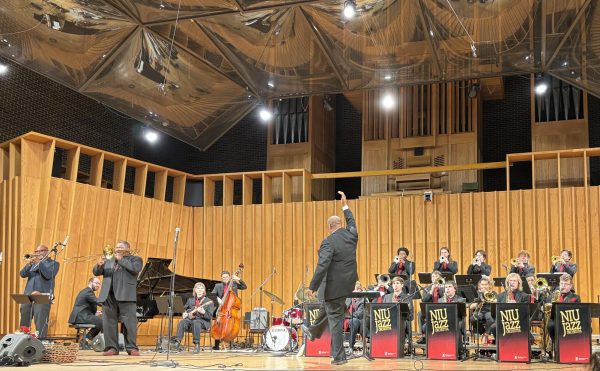The life of a Huskie cheerleader
October 13, 2005
What’s the life of a cheerleader really like? According to the media, it seems to be easy. Many of today’s movies depict cheerleaders as nothing more than popular, attractive girls without any athletic or academic chops. From the success of films like “Bring It On” and “But I’m a Cheerleader!” it seems Americans embrace these stereotypes wholeheartedly. But are they true? I decided to become an NIU cheerleader for a week to find out.
Day 1: Practice
My first impression of the cheerleaders was complete awe. There are approximately 40 of them – some male, most female. About half of them were practicing double back flips while the others were stretching limbs at unbelievable angles. Already, two parts of the stereotype are disproved: not only is the squad partly male, but the cheerleaders are skilled athletes.
Freshman accountancy major Derek Carter is a prime example of both.
“[Cheerleading] is a lot harder than you think it is,” Carter said. “It requires a lot of strength conditioning, a lot of practice and a lot of endurance. It requires you to use different muscle groups than other sports.”
The team also seemed different from what I remember of my high school squad. Not only do members cheer for football, basketball and volleyball, they make public appearances and participate in camps over the summer. Senior psychology major Hollian Montgomery said the requirements for college cheerleading are much higher.
“This is a lot more skill-oriented than in high school,” Montgomery said. “Before, you just had to touch and flip. Now you have elite tumbling skills along with jumps and the stunt level is a lot harder.”
Watching the cheerleaders practice supported her point. As they went over their sophisticated routine, I slumped in the corner, already doubting my ability to keep up with the squad.
Day 2: Training
Cheerleaders not only practice for three hours a day, three days a week, they also get up and train in the Campus Recreation Center three mornings a week at 6 a.m. By the time I got in, the cheerleaders were already there, using the elliptical machines. I sluggishly got on a machine, and while the cheerleaders’ legs whirred on the pedals, mine slowly plodded along. After the 10 required minutes, I was about to collapse. Instead, it was time to lift weights.
Pre-elementary education major Crystal Prue explained the training routine: an hour to an hour and a half of squatting, leg lifts, arm raises and toe lifts, to name a few. All the practice and training amounts to about 20 to 25 hours a week for the squad. I assumed there must be some sort of financial or academic compensation for all their work. But cheerleaders at NIU don’t get
scholarships.
“We think [it’s ridiculous]” Prue said. “But it’s what we love to do.”
Day 3: Practice before the game
By now the squad realized there was no way I could perform with them without seriously hindering their routine. So head coach Shaun Jones let me experience what it’s like to be on the field during a game by running out with a flag. All the cheerleaders were kind and encouraging – not snotty and arrogant like they’re usually portrayed. As a group, they seem to be supportive of one another and are constantly joking and having a good time.
“We spend over 20 hours a week together,” said Hillary Kirschbaum, sophomore cheerleader and nursing major. “Some of the girls on this team are my best friends. It’s a super supportive atmosphere because it’s a team sport, and we want to do better for others.”
As the cheerleaders ran through their game-day routine, I noticed a few football players walk by and peer in to our practice room.
“I used to want to be a cheerleader,” said junior corner Keafta Dokes. “I thought it would be fun to do those stunts and throw some girls around.”
Day 4: The Game: Oct. 5, NIU vs. Miami Ohio
The time came to go out on the field and show NIU what I’ve got. I donned the skimpy uniform and got ready.
The cheerleaders were directed to wear their hair half up in curls and red lipstick. But since I was only running out with the flag, I managed to escape this rule.
As I stood on the sidelines and prepared to run out, the excitement and energy of the crowd became infectious. Nothing compares to the feeling of standing in front of thousands of people, representing something that has such a positive meaning to so many people. As I waited with my flag, labeled “S” (the last “S” in “Huskies”), a group of fans in the bleachers spotted my flag, and began chanting “S! S! S!” Before I knew it, half the people in the bleachers were chanting along and pounding their fists.
Suddenly, we were running out on the field with our flags. I held mine straight ahead of me, trying to keep it upright while also trying to keep up with the others. This proved to be difficult because the flapping fabric of the flag in the wind threatened to pull me backwards. As I ran, the marching band crossed the field and parachuters descended from the sky. Everything seemed like a blur, except the huge widening gap between myself and “H-U-S-K-I-E.”
I finally reached the end of the field, tossed my flag aside, and took a deep breath. Running across the field was only slightly embarrassing compared to the excitement of it, and I can see now why the cheerleaders work so hard for this.
The Aftermath
Working out and practicing with the cheerleaders for a week only gave me a small glimpse of what they are like, but they left me with a strong impression. Not only do these cheerleaders contradict their stereotype, they cheer not for recognition, money or even a career, but because they love to. Learning (or attempting to learn) first-hand just how difficult cheerleading is gave me a new respect for the sport and entirely different expectations of cheerleaders.










